HOW TO CARE FOR YOUR AFRICAN PYGMY HEDGEHOG

Copyright © 1999 - Laura Mowrey - All Rights Reserved


DISHES:

I use heavy, low sided glass dishes as many hedgehogs just love to over turn their bowls. You can also use
what is called a coop-cup, which is a stainless steel holder that bolts onto the side of
your cage, and holds a cup to place the food in.

Some examples of the different dishes you can use. *Note the two forms of "Coop-Cups" in back.
The stainless steel bowls slide into the brackets, 1 of which simply hooks on the side of the cage,
and the other bolts on (I recommend the bolt-type for
hedgehogs). You can order these from Foster and Smith at:
Foster and Smith On-line Catalog
Here is a cute example of what you could use for a treat cup. I bought this at Pet Smart and it attaches to the
cage, and holds a small dish in which to leave your hedgie his or her favorite treats!
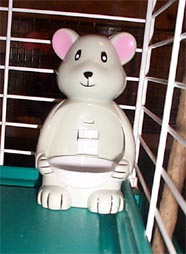

WATER:

If your hedgie will drink from a bowl and not overturn it, then that is great!! Make sure the bowl you use is
stainless steel or glass, plastic gives off a gas into the water that can be harmful, and unless you know
the crock dishes you have are lead-free, that poses a problem as well. Many of those dishes are made
over seas, the making of which is not regulated in most cases. If you choose to use a water bottle,
make absolutely certain your hedgehog knows how to drink from it. Some do not, and you cannot risk
dehydration. Finding out what the previous owner was using for his/her water is very helpful. Some
have reported chipped teeth from hedgies who drink from water bottles. This has not happened to any of
mine, but it certainly is something to consider when choosing a water receptacle. Make sure to give
fresh, clean water every single day.....and wash the water holders as well. Bacteria builds up
quickly in them.
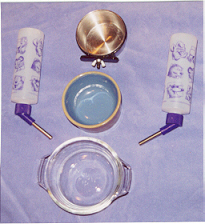
Just a few examples of what you can use to keep drinking water in.
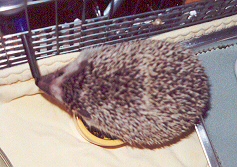
Emma getting a drink of water.
BATHEING YOUR HEDGEHOG:
case may be with yours, sometimes bathing becomes necessary whether they like it or not. I have 1
little girl who has to be put in warm water just deep enough to cover her feet almost every day to soak off the
dried poop she accumulates on them from pooping on her wheel each night and running through it! Rarely
do my hedgies ever need and all-over bath, but when they do I use nice warm water, with a tiny bit of
very mild soap...something designed for kittens, bunnies etc should do fine. I have also used baby
products; Johnson and Johnson makes a tear-free lavender scented bath-wash that smells heavenly, but use it very
sparingly and make sure whatever soap you use, that is gets thoroughly rinsed off. If your hedgie
has
very dry skin, try a couple drops of olive oil in the bathwater, and maybe an oatmeal-based
scent-free shampoo.
I have found the best tool when washing hedgies is a soft toothbrush. It works great for getting those feet
clean, and working through their quills as well.
Once your hedgie is bathed and rinsed off, wrap him/her in a towel to soak up most of the excess water and then
transfer them to another dry towel (I pre-warm my towels in the microwave for my hedgies) and keep them
in it until they're completely dry, especially in the colder seasons. Whatever you do, do NOT let your
hedgehog get chilled!!
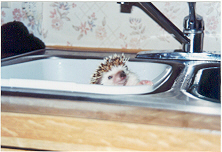
Ok mom, I am ready to get outta here now!! **Photo compliments of Hobie

Not to worry folks, this is a no more tears shampoo on me!!
**Photo compliments of Savannah

Tommy, all snuggled in a warm towel after his bath.
Miss Zoey's Bath Time:
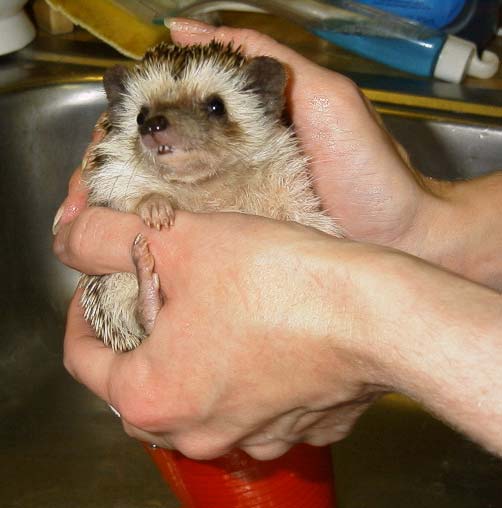
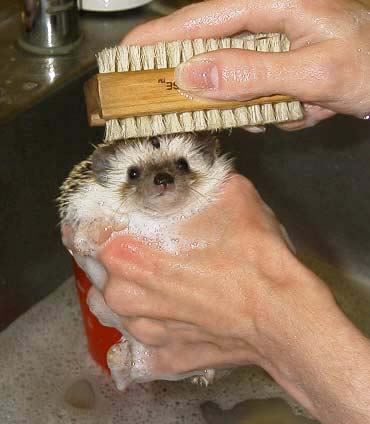
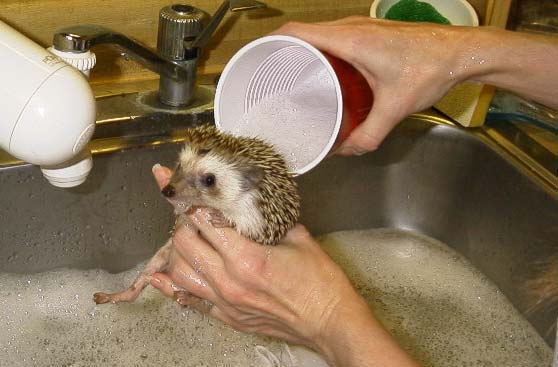
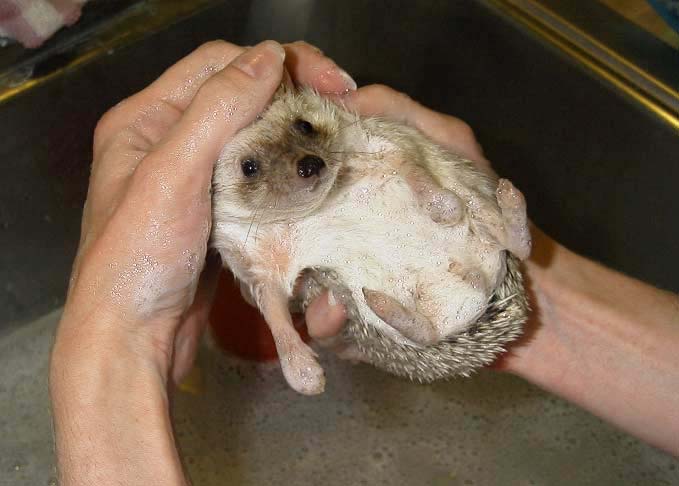
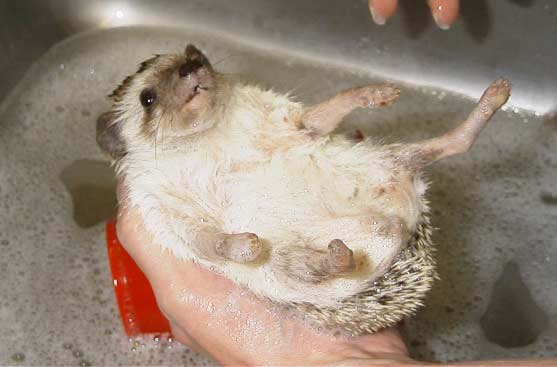
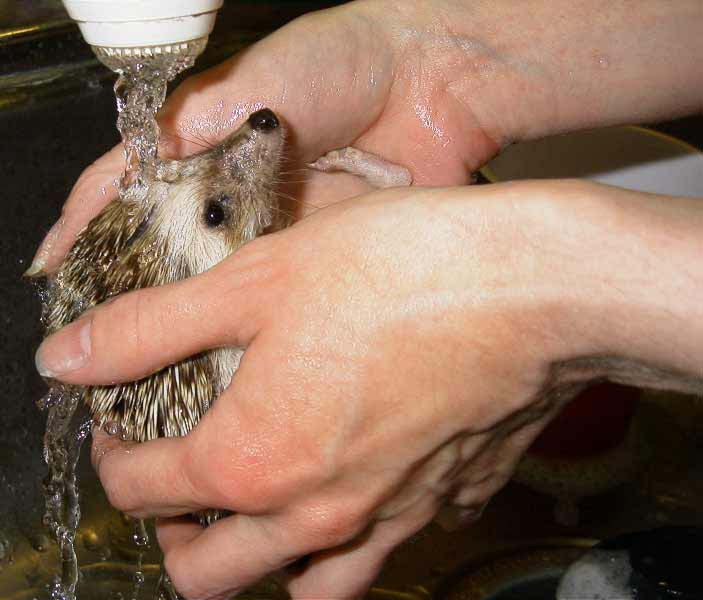

A SPOOF ON BATHEING YOUR HEDGEHOG:
1. Fill tub.
2. Check water temp.
3. Try to plop hedge in tub.
4. Hedgie sees bath and tries to escape up my shirt sleeve.
5. Remove hedgie from shirt sleeve.
6. Try to plop hedgie in tub.
7. Hedgie sees bath and tries to avoid it by latching on to my
shirt sleeve.
8. Try to plop hedgie in tub.
9. Hedgie knows bath in inevitable but still won't comply.
10. Juggle hedgie as she tries to slip through my hands.
11. Try to plop hedgie in tub.
12. Finally, after many attempts and many minutes hedgie is finally in tub.
13. Empty & refill the tub because hedgie confused it for her litter box.
14. Cup water over hedgie to wet her down.
15. Get towel and dry off because somehow, the water ended up on me.
16. Try, once again, to cup water over hedgie.
17. Get towel and dry off because hedgie shook her quills off and you got
wet again.
18. Empty & refill tub again because hedgie confused to tub for her litter
box. Again.
19. Get out the shampoo.
20. Try to keep hedgie from climbing out of the tub.
21. Laugh as hedgie realizes the tub is too slippery for her to climb out of.
22. Laugh even harder as hedgie continues, unsuccessfully, to climb out of
the tub.
23. Get out the tooth brush.
24. Try to keep hedgie from climbing out of the tub.
25. Laugh as, once again, hedgie realizes the tub is too slippery for her to
climb out of.
26. Lather up the hedgie with some shampoo.
27. Try to wash hedgie as she runs circles around the tub.
28. Get a towel because you now have soap in your eye.
29. Scream because hedgie accidentally spiked you when she saw toothbrush
coming at her.
30. Proceed to wash hedgie.
31. Empty & refill tub because hedgie had to use the little girl's room.
again.
32. Scrub poopy feet with toothbrush.
33. Turn water on and cup it over hedgie to get the soap.
off.
34. Get towel because, of course, you got wet again>
35. Inform hedgie it is not sanitary to drink bathwater>
36. Rinse remaining soap off hedgie.
37. Rinse remaining soap off yourself.
38. Wrap hedgie in a nice warm towel.
39. Wrap yourself in a towel.
40. Try to snuggle with hedgie while simultaneously convincing her she
needed a bath, the other animals were starting to complain of the smell.
41. Try to win forgiveness with a mealie.
42. If hedgie still won't budge, add a wax worm.
43. If attitude persists, throw a cricket into the mix.
44. Snuggle with hedgie.
45. Put hedgie in her bed to rest.
46. Put yourself in bed to rest.
47. Wake up and play with hedgie.
48. Scream in frustration because hedgie has poopy feet.
49. Put hedgie on floor for supervised play.
50. Cry because while your back was turned for 2 seconds, hedgie managed to
anoint 3 times.
51. Refer to step 1.
Bath Spoof Written by:
Kerri LeMotte
HISSING, CLICKING AND BALLING UP:

Hedgehogs will ball and quill up, hiss, pop, and make clicking noises in response to both fear and annoyance.
With a new hedgie, it is most likely in response to fear. Your hedgehog hasn't gotten the
chance to know and trust you as of yet, but with a little patience and a lot of attention and handling, your pet
should come around. Even very tame and friendly hedgies may respond this way when first picked
up....especially if you've wakened them, but as in this case, should calm down quickly.
WHAT DOES THAT SOUND MEAN?
Soft Purring and Whistling: This is a sign of pure contentment.
Puffing: Displeasure, uncertainty.
Snorting or "Sneezing": Usually accompanies puffing and means the same thing.
Hissing and Clicking: These are warning sounds of irritation and or fear.
Snuffling: Happily checking things out.
Chirping: Usually done by males while breeding and by nursing babies.
Screaming: Physical pain or fear.
Sounds Heard During Sleep: Snoring, huffing, chirping are all common sounds made while their sleeping".
SOCIALIZING YOUR HEDGEHOG:

So you have a new hedgehog and he or she isn't much other then a sharp-quilled tight ball of hissing, popping,
clicking attitude??!! Don't despair, this happens ALL the time and doesn't mean your pet will be
this way forever. Hedgehogs act defensive for any number of reasons, a big one being just plain out of
fright. Give your new pet some time to adjust....daily handling is important, even if its just to lay in
your lap and sniff at you. Talk softly to your new baby, offer treats by hand (whatever they like the
best; mealworms, bits of cooked unseasoned chicken etc). Now, take an old t-shirt, or a similar piece
of cloth and wear it around all day long (make sure its nothing with loopy or lose threads). After
your scent is embedded into it, slide it into your hedgies bed. This will give him the chance to
become familiar with your smell and learn that it is not a threatening thing. Above all, have patience. It is
rare for a hedgie to never come around, but it does sometimes take time, perseverance, and consistent
handling. You cannot expect a hedgehog who is only paid attention to occasionally to be a
loving, tame pet.

One way to help your friend warm up to you is by offering treats by hand. *
Photo compliments of Shonda Statini and her hedgehog Precious.
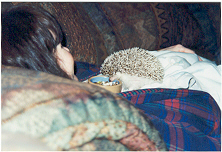
One thing you can do to get your hedgehog used to you, is to place his/her somewhere on you with their food dish.
**Photo compliments of Hobie.
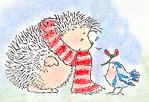
NAIL TRIMMING:
Trimming your hedgehog's toenails is something a lot of people feel intimidated by as it's not always as easy
task unless you have a very tame and tolerant hedgehog! The easiest way I have found to trim my
hedgie's nail are to put them in a couple inches of warm water, as this makes them open up. I then take hold of
one foot at a time and using a nail clipper (I use the same kind made for people), I carefully clip each
nail. This can be a little difficult at first, until you get the hang of it as your hedgehog will
probably be wanting to move around at the same time you have a hold of his foot. Be very careful not to twist a
leg in the process! Make sure when your clipping the nails, not to cut too far back or you will cut the
"quick" causing your hedgie to bleed. You can see the quick through the nails...it will look pink. Cut
below it. If for some reason you do accidentally cause him to bleed (that happens to the best of us),
make sure you keep a product called "STOP QUIK" on hand, dab a little bit on the nail and
it will stop the bleeding. Flour will work in a pinch, but it is best to have Stop Quik available and
next to the sink.
I cut my hedgies nails every 2 or 3 weeks. They grow fast, and can quickly grow, curl under, and cut right into
the soft pad of their feet, which will not only cause pain, but will also open them up to infection.
Also, nails that are overgrown can cause foot deformities and make it difficult for your hedgie
to run on his wheel.
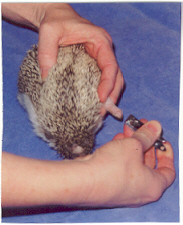
Miss Emma getting her nails trimmed.

An example of what can happen if your do not keep your hedgies nails trimmed properly.
WATCH THOSE FEET!
I feel it necessary to just make a quick mention of paying attention to your hedgies feet, especially if you ever
let him roam around your house at all. Hedgehogs are notorious for getting little threads, hairs,
carpet fibers.....you name it.....caught on their feet. I have personally known of 2 hedgies to whom this
happened to and by the time the owners took notice of it, each had to have a foot amputated from the blood
circulation being cut off for so long by whatever got wound around their foot. The 3rd hedgie had a badly
infected foot, but thankfully only lost 2 toes as a result.
MY HEDGEHOG HAS A BALD SPOT
ON HIS HEAD!
You will notice that there is a bald area that runs down the center of your hedgehogs head towards his back. Not
to worry, this is completely natural, and enables the hedgehog to roll into a ball. This area is an
easy spot to check for dry skin on your hedgie! :)
DRY SKIN:
If you notice some flaking of dry skin on your hedgie (real easy to see in the quill-less area of the head), it
can mean a mite infestations or it may just be plain old dry skin. After your Vet has ruled out mites, a
way to soothe your hedgies skin and keep it nice and soft is to give it oatmeal baths. Try useing Aveeno
soap (it is oatmeal based) and for an extra nice touch, place some uncooked oatmeal in some
cheesecloth, tie it off with some string and soak it in your hedgies bath. Oatmeal will not hurt your hedgie and
it is a very effective skin softening agent. After any bath, make sure you rinse your hedgehog
throughly!
Often dry skin is a sign of something lacking in the diet, so I recommend a product called Spectrum Essental
Organic Oil, which contains Omega 3, 6, and 9 fatty acids. Fred Meyers Health Food Section carries
this product under refrigeration. One tiny drop per day on the food is plenty.
RAGGEDY EARS:
If your hedgies ears look a bit jagged or tattered on the ends, have your Vet check for mites and or fungal
infections. In the case of my hedgies, they checked out clean at the Vets so I simply treated them at home. I
have used a number of things on my hedgehogs ears with success; Bag Balm, and Shea Butter being two of
them. They both worked equally well to make the raggedy edges disappear and keep their ears nice and
smooth.
WILL A HEDGEHOG FIT IN WITH OUR OTHER PETS?:
As with anything else, careful consideration should be given before introducing any new pet into a household of
established pets. Often people ask me if a hedgehog will get along with their cat or dog. I can only
tell them that hedgehogs and cats and dogs should not be expected to "get along" with each other, but
that doesn't mean they cannot live somewhat harmoniously in the same household. My cats will not bother
any of my hedgies....one poke and the cats learned their lessons quickly. The same goes for my
dogs. However, there is always the exception....one being our dog Maty, a little miniature doxie we had who I
swear would have eaten any hedgehog, quills and all. My best advice is to tell you to just use caution
and common sense. Don't leave your hedgie unattended around other pets and make sure their cage is
securely locked when the hedgie is in it so that your dog or cat cannot get to them. More then likely,
your hedgehog will not appreciate having other animals sniffing around their cage, so hopefully you
will have a place to put their cage where they won't be disturbed.
THE OLDER HEDGEHOG:
A lot of folks have asked what some of the more common signs of ageing are in hedgehogs. One would be their
color. More often then not, the color of the quills fades a bit and the tips are not nearly as sharp as with a
younger hedgehog. Their faces take on an older look as well, fur color fades a bit and they may look a
bit disheveled. Older hedgies tend to slow down a bit, are not as active, and require more warmth since
they tend to chill easier. You might see that getting up and moving after they’ve been sleeping is
difficult at first. In the older hedgehogs I have observed, their nails seem to thicken and may turn more
yellowish with age. In observing their teeth, you may note some are missing, or see teeth that
are worn down (although this can be caused by other things as well). Many of the traits we see in most other
older animals and even in human beings is pretty universal, and applies to hedgehogs as well. Do not
however, “assume” a change in your animals behavior is due to old age. Always make sure to check with
your Vet to eliminate the possiblity of there being an illness present.
HOW MANY OF OUR YEARS EQUALS A HEDGEHOGS?
We all know that animals age faster then we humans do. You know how they say dogs age appx 7 years for every 1
year of ours? Ever wonder how hedgehogs age in comparison to us human beings? Check this out:
2 month old human = 10 year old hedgehog
6 month old human = 20 year old hedgehog
14 month old human = 30 year old hedgehog
3 year old human = 40 year old hedgehog
3 1/2 year old human = 50 year old hedgehog
3 3/4 year old human = 60 year old hedgehog
4 year and 2 month old human = 70 year old hedgehog
5 year and 4 month old human = 80 year old hedgehog
6 year and 2 month old human = 90 year old hedgehog
7 year and 8 month old human = 100 year old hedgehog
WOW!!
 NEXT
NEXT
 BACK TO TABLE OF CONTENTS
BACK TO TABLE OF CONTENTS


























 NEXT
NEXT BACK TO TABLE OF CONTENTS
BACK TO TABLE OF CONTENTS